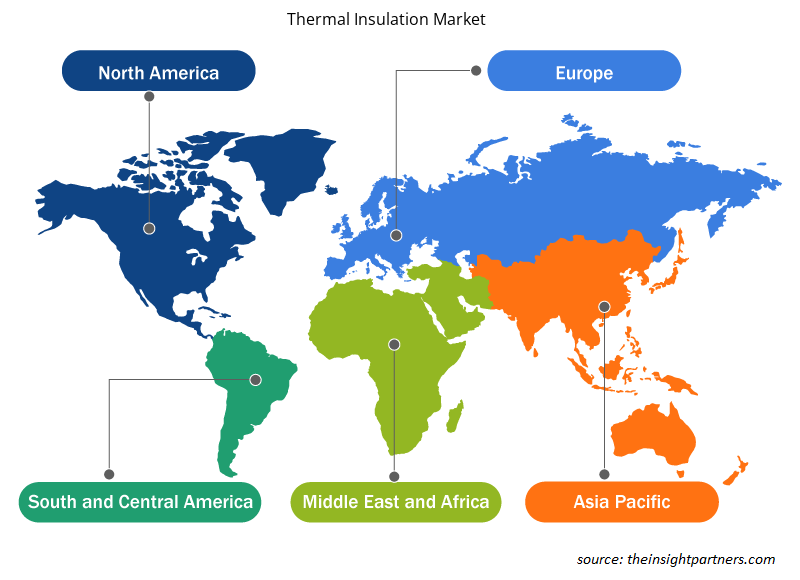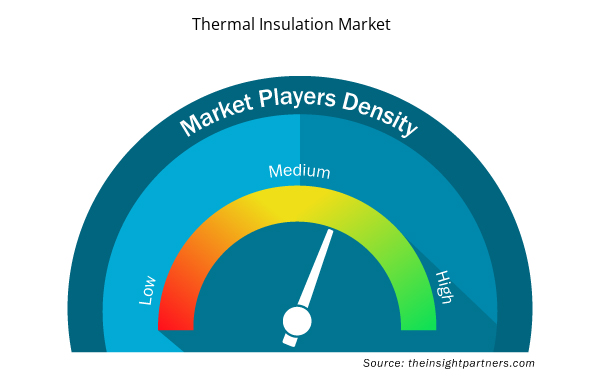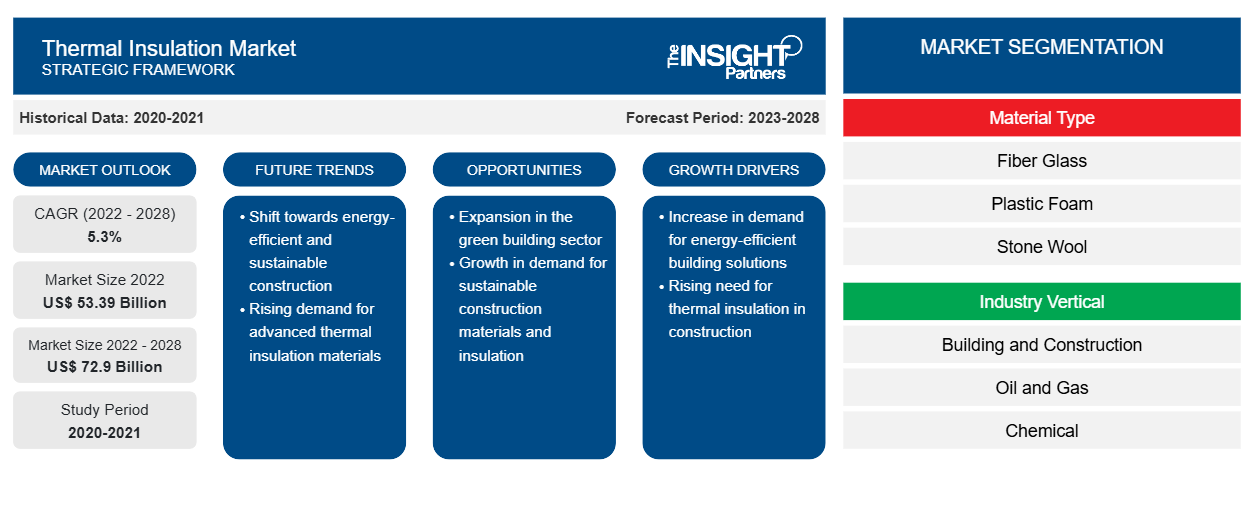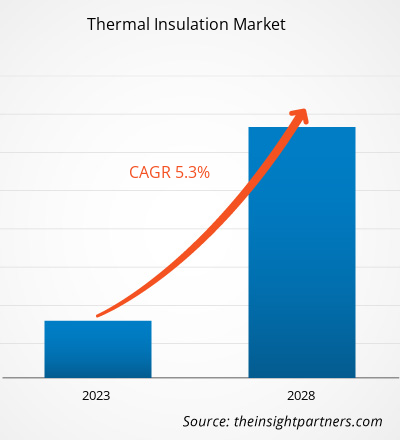Se espera que el mercado de aislamiento térmico crezca de US$ 53.39 mil millones en 2022 a US$ 72.90 mil millones en 2028; se espera que crezca a una CAGR del 5,3% entre 2022 y 2028.
La demanda de aislamiento térmico ha aumentado debido a sus ventajas: reduce los costes energéticos y la transferencia de calor entre dos objetos de diferente temperatura. Los materiales de aislamiento térmico ofrecen un aislamiento en el que el calor radiativo se refleja, reduce y absorbe. Las empresas se están centrando en ofrecer productos ligeros como el plástico, ya que es fácil de instalar y requiere menos tiempo y esfuerzo. Se espera que estos factores aumenten el crecimiento del mercado del aislamiento térmico .
Se prevé que el mercado de aislamiento térmico experimente un crecimiento significativo en los próximos años debido a la fuerte presencia de actores destacados, como BASF SE, Bayer AG, ROCKWOOL A/S, Johns Manville, SAINT GOBAIN SA, Kingspan Group PLC, Dow Chemicals Company, Owens Corning, Asahi Kasei Corporation y DuPont. Una gran variedad de productos de aislamiento térmico atrajeron la atención de los consumidores. Es probable que la creciente conciencia sobre los beneficios del aislamiento de alta temperatura, incluida la resistencia a temperaturas elevadas y choques térmicos, baja conductividad térmica, beneficios ambientales y rentabilidad, impulse el crecimiento del mercado de aislamiento térmico durante el período de pronóstico.
En 2021, Asia Pacífico tuvo la mayor participación del mercado mundial de aislamiento térmico. Sin embargo, se estima que América del Norte registrará la CAGR más alta en el mercado durante el período de pronóstico. El mercado de APAC está segmentado en China, India, Australia, Japón, Corea del Sur y el resto de APAC. La industria de la construcción es una de las industrias en auge en APAC debido al rápido aumento de la población; esto en última instancia conduce a la alta demanda de productos de aislamiento térmico. Además, el aumento de los niveles de ingresos disponibles de los consumidores y el crecimiento de la población de clase media son algunos de los factores clave que impulsan el crecimiento del mercado de aislamiento térmico en la región.
Personalice este informe según sus necesidades
Obtendrá personalización en cualquier informe, sin cargo, incluidas partes de este informe o análisis a nivel de país, paquete de datos de Excel, así como también grandes ofertas y descuentos para empresas emergentes y universidades.
- Obtenga las principales tendencias clave del mercado de este informe.Esta muestra GRATUITA incluirá análisis de datos, desde tendencias del mercado hasta estimaciones y pronósticos.
Impacto de la pandemia de COVID-19 en el mercado del aislamiento térmico
Antes de la pandemia de COVID-19, el crecimiento del mercado de aislamiento térmico se debía principalmente a la creciente demanda de edificios y actividades de construcción. Sin embargo, el mercado enfrentó obstáculos durante el primer trimestre de 2020 debido al cierre de empresas, la escasez de materias primas y mano de obra, y la disminución de las actividades de construcción y transporte. La pandemia de COVID-19 provocó una recesión económica en los primeros meses de 2020, lo que creó dificultades financieras para los consumidores de ingresos bajos y medios.
Además, debido a las restricciones, el cierre de muchas empresas de construcción y fabricación afectó el crecimiento del mercado del aislamiento térmico. Además, durante la pandemia, la escasez de mano de obra fue una preocupación importante para la industria del aislamiento térmico. Esto llevó a un cambio hacia la mecanización, la automatización y la fabricación fuera del sitio en la industria del aislamiento térmico.
Perspectivas del mercado
Beneficios del uso de aislamiento térmico
El aislamiento térmico reduce los movimientos de calor y la condensación de vapor. Por lo tanto, evita la humedad, el moho, la congelación, la deformación que puede producirse en el edificio y el debilitamiento de las piezas de hierro debido a la corrosión; y ayuda a la conservación del edificio. Además, en diversas industrias, se pueden obtener enormes beneficios de ahorro energético con una menor conductividad térmica en la construcción del revestimiento mediante el uso de productos como el aislamiento BTU-BLOCK.
Según el tipo de material, el mercado global se clasifica en fibra de vidrio , espuma plástica, lana de roca, silicato de calcio, vidrio celular y otros. En 2021, el segmento de fibra de vidrio representó la mayor participación en los ingresos y se espera que la espuma plástica represente la tasa de crecimiento más alta durante el período de pronóstico. Por vertical de la industria, el mercado global está segmentado en construcción y edificación, petróleo y gas, química, aeroespacial y defensa, automotriz, farmacéutica y otros. El segmento de construcción y edificación representó la mayor participación en los ingresos.
BASF SE, Bayer AG, ROCKWOOL A/S, Johns Manville, SAINT GOBAIN SA, Kingspan Group PLC, Dow Chemicals Company, Owens Corning, Asahi Kasei Corporation y DuPont son algunos de los actores clave que operan en el mercado del aislamiento térmico. Estas empresas ofrecen una amplia gama de carteras de productos para el mercado. Las empresas están presentes en regiones en desarrollo, lo que ofrece oportunidades de mercado lucrativas. Los actores del mercado están desarrollando productos innovadores y de alta calidad para satisfacer los requisitos de los clientes.
Informe Destacado
- Tendencias progresivas de la industria en el mercado para ayudar a los actores a desarrollar estrategias efectivas a largo plazo
- Estrategias de crecimiento empresarial adoptadas por los mercados desarrollados y en desarrollo
- Análisis cuantitativo del tamaño del mercado de productos de aislamiento térmico de 2022 a 2028
- Estimación de la demanda mundial de aislamiento térmico
- Análisis PEST para ilustrar la eficacia de los compradores y proveedores que operan en la industria
- Avances recientes para comprender el escenario competitivo del mercado
- Tendencias y perspectivas del mercado y factores que impulsan y restringen el crecimiento del mercado del aislamiento térmico
- Asistencia en el proceso de toma de decisiones destacando las estrategias de mercado que sustentan el interés comercial, lo que conduce al crecimiento del mercado.
- El tamaño del mercado de aislamiento térmico en varios nodos
- Descripción detallada y segmentación del mercado, así como la dinámica de la industria del aislamiento térmico.
- Tamaño del mercado de aislamiento térmico en varias regiones con oportunidades de crecimiento prometedoras
Perspectivas regionales del mercado del aislamiento térmico
Los analistas de Insight Partners explicaron en detalle las tendencias y los factores regionales que influyen en el mercado de aislamiento térmico durante el período de pronóstico. Esta sección también analiza los segmentos y la geografía del mercado de aislamiento térmico en América del Norte, Europa, Asia Pacífico, Oriente Medio y África, y América del Sur y Central.

- Obtenga datos regionales específicos para el mercado de aislamiento térmico
Alcance del informe de mercado de aislamiento térmico
| Atributo del informe | Detalles |
|---|---|
| Tamaño del mercado en 2022 | US$ 53,39 mil millones |
| Tamaño del mercado en 2028 | US$ 72,9 mil millones |
| CAGR global (2022-2028) | 5,3% |
| Datos históricos | 2020-2021 |
| Período de pronóstico | 2023-2028 |
| Segmentos cubiertos | Por tipo de material
|
| Regiones y países cubiertos | América del norte
|
| Líderes del mercado y perfiles de empresas clave |
|
Densidad de actores del mercado de aislamiento térmico: comprensión de su impacto en la dinámica empresarial
El mercado de aislamiento térmico está creciendo rápidamente, impulsado por la creciente demanda de los usuarios finales debido a factores como la evolución de las preferencias de los consumidores, los avances tecnológicos y una mayor conciencia de los beneficios del producto. A medida que aumenta la demanda, las empresas amplían sus ofertas, innovan para satisfacer las necesidades de los consumidores y aprovechan las tendencias emergentes, lo que impulsa aún más el crecimiento del mercado.
La densidad de actores del mercado se refiere a la distribución de las empresas o firmas que operan dentro de un mercado o industria en particular. Indica cuántos competidores (actores del mercado) están presentes en un espacio de mercado determinado en relación con su tamaño o valor total de mercado.
Las principales empresas que operan en el mercado de aislamiento térmico son:
- BASF SE
- Bayer AG
- LANA DE ROCA A/S
- Johns Manville
- SAINT GOBAIN SA
Descargo de responsabilidad : Las empresas enumeradas anteriormente no están clasificadas en ningún orden particular.

- Obtenga una descripción general de los principales actores clave del mercado de aislamiento térmico
El "Análisis del mercado de aislamiento térmico hasta 2028" es un estudio especializado y profundo de la industria de bienes de consumo con un enfoque especial en el análisis de tendencias del mercado global de aislamiento térmico. El informe tiene como objetivo proporcionar una descripción general del mercado con una segmentación detallada del mercado.
El mercado de aislamiento térmico está segmentado por tipo de material, sector industrial y geografía. Según el tipo de material, el mercado global está segmentado en fibra de vidrio, espuma plástica, lana de roca, silicato de calcio, vidrio celular y otros. Según el sector industrial, el mercado global está segmentado en construcción, petróleo y gas, productos químicos, aeroespacial y defensa, automoción, productos farmacéuticos y otros. Por geografía, el mercado está ampliamente segmentado en América del Norte, Europa, Asia Pacífico (APAC), Oriente Medio y África (MEA), y América del Sur y Central.
Perfiles de empresas
BASF SE, Bayer AG, ROCKWOOL A/S, Johns Manville, SAINT GOBAIN SA, Kingspan Group PLC, Dow Chemicals Company, Owens Corning, Asahi Kasei Corporation y DuPont son los actores destacados que operan en el mercado global de aislamiento térmico.
- Análisis histórico (2 años), año base, pronóstico (7 años) con CAGR
- Análisis PEST y FODA
- Tamaño del mercado Valor/volumen: global, regional, nacional
- Industria y panorama competitivo
- Conjunto de datos de Excel



Report Coverage
Revenue forecast, Company Analysis, Industry landscape, Growth factors, and Trends

Segment Covered
This text is related
to segments covered.

Regional Scope
North America, Europe, Asia Pacific, Middle East & Africa, South & Central America

Country Scope
This text is related
to country scope.
Preguntas frecuentes
Based on the industry vertical, building and construction segment accounted for the highest share of the global market in 2021. Thermal insulation materials are increasingly used in the building and construction sector as they slow heat transfer through the enclosure to reduce heat gain and loss. Thermal insulation is increasingly becoming an essential technology to reduce energy consumption in buildings by preventing heat gain/loss through the building envelope.
Increasing demand for high-temperature thermal insulation is a recent trend in the global thermal insulation market. Growing awareness about the benefits of high-temperature insulation, including resistance to elevated temperatures and thermal shocks, low thermal conductivity, environmental benefits, and cost efficiency, is likely to propel the thermal insulation market growth over the forecast period. In addition, thermal insulation can protect equipment and help achieve extraordinarily high or low temperatures with reduced accident risks.
Based on the material type, plastic foam is expected to be the fastest-growing segment during the forecast period. Plastic foams are a type of polymer that includes voids and cells within the polymers. It is a lightweight cellular foam that is increasingly used as an insulation material.
Increase in demand for lightweight thermal insulation and growth in the building and construction industry are drivers of thermal insulation. Thermal insulation material offers insulation in which the radiative heat is reflected, reduced, and absorbed. Thermal insulation is a powerful technology that is used to reduce energy consumption in buildings by preventing heat gains or losses through the building covering.
The major players operating in the global thermal insulation market BASF SE, Bayer AG, ROCKWOOL A/S, Johns Manville, SAINT GOBAIN S.A, Kingspan Group PLC, Dow Chemicals Company, Owens Corning, Asahi Kasei Corporation, and DuPont.
In 2021, Asia Pacific accounted for the largest share of the global thermal insulation market. The Asia Pacific thermal insulation market is segmented into China, India, Japan, South Korea, Australia, and the Rest of Asia Pacific. These countries are witnessing growth in various end-use industries which will boost the growth of the thermal insulation market in the region. Growing urbanization in the emerging economies of Asia Pacific has led to an increased requirement for better commercial and public infrastructure. Rural-to-urban migration in developing countries in the region is increasing the construction activity in urban areas. As urban buildings are usually more insulation intensive than those in rural areas, this will, in turn, stimulate demand for thermal insulation in residential buildings.
Trends and growth analysis reports related to Chemicals and Materials : READ MORE..
The List of Companies - Thermal Insulation Market
- BASF SE
- Bayer AG
- ROCKWOOL A/S
- Johns Manville
- SAINT GOBAIN S.A
- Kingspan Group PLC
- Dow Chemicals Company
- Owens Corning
- Asahi Kasei Corporation
- DuPont
The Insight Partners performs research in 4 major stages: Data Collection & Secondary Research, Primary Research, Data Analysis and Data Triangulation & Final Review.
- Data Collection and Secondary Research:
As a market research and consulting firm operating from a decade, we have published and advised several client across the globe. First step for any study will start with an assessment of currently available data and insights from existing reports. Further, historical and current market information is collected from Investor Presentations, Annual Reports, SEC Filings, etc., and other information related to company’s performance and market positioning are gathered from Paid Databases (Factiva, Hoovers, and Reuters) and various other publications available in public domain.
Several associations trade associates, technical forums, institutes, societies and organization are accessed to gain technical as well as market related insights through their publications such as research papers, blogs and press releases related to the studies are referred to get cues about the market. Further, white papers, journals, magazines, and other news articles published in last 3 years are scrutinized and analyzed to understand the current market trends.
- Primary Research:
The primarily interview analysis comprise of data obtained from industry participants interview and answers to survey questions gathered by in-house primary team.
For primary research, interviews are conducted with industry experts/CEOs/Marketing Managers/VPs/Subject Matter Experts from both demand and supply side to get a 360-degree view of the market. The primary team conducts several interviews based on the complexity of the markets to understand the various market trends and dynamics which makes research more credible and precise.
A typical research interview fulfils the following functions:
- Provides first-hand information on the market size, market trends, growth trends, competitive landscape, and outlook
- Validates and strengthens in-house secondary research findings
- Develops the analysis team’s expertise and market understanding
Primary research involves email interactions and telephone interviews for each market, category, segment, and sub-segment across geographies. The participants who typically take part in such a process include, but are not limited to:
- Industry participants: VPs, business development managers, market intelligence managers and national sales managers
- Outside experts: Valuation experts, research analysts and key opinion leaders specializing in the electronics and semiconductor industry.
Below is the breakup of our primary respondents by company, designation, and region:

Once we receive the confirmation from primary research sources or primary respondents, we finalize the base year market estimation and forecast the data as per the macroeconomic and microeconomic factors assessed during data collection.
- Data Analysis:
Once data is validated through both secondary as well as primary respondents, we finalize the market estimations by hypothesis formulation and factor analysis at regional and country level.
- Macro-Economic Factor Analysis:
We analyse macroeconomic indicators such the gross domestic product (GDP), increase in the demand for goods and services across industries, technological advancement, regional economic growth, governmental policies, the influence of COVID-19, PEST analysis, and other aspects. This analysis aids in setting benchmarks for various nations/regions and approximating market splits. Additionally, the general trend of the aforementioned components aid in determining the market's development possibilities.
- Country Level Data:
Various factors that are especially aligned to the country are taken into account to determine the market size for a certain area and country, including the presence of vendors, such as headquarters and offices, the country's GDP, demand patterns, and industry growth. To comprehend the market dynamics for the nation, a number of growth variables, inhibitors, application areas, and current market trends are researched. The aforementioned elements aid in determining the country's overall market's growth potential.
- Company Profile:
The “Table of Contents” is formulated by listing and analyzing more than 25 - 30 companies operating in the market ecosystem across geographies. However, we profile only 10 companies as a standard practice in our syndicate reports. These 10 companies comprise leading, emerging, and regional players. Nonetheless, our analysis is not restricted to the 10 listed companies, we also analyze other companies present in the market to develop a holistic view and understand the prevailing trends. The “Company Profiles” section in the report covers key facts, business description, products & services, financial information, SWOT analysis, and key developments. The financial information presented is extracted from the annual reports and official documents of the publicly listed companies. Upon collecting the information for the sections of respective companies, we verify them via various primary sources and then compile the data in respective company profiles. The company level information helps us in deriving the base number as well as in forecasting the market size.
- Developing Base Number:
Aggregation of sales statistics (2020-2022) and macro-economic factor, and other secondary and primary research insights are utilized to arrive at base number and related market shares for 2022. The data gaps are identified in this step and relevant market data is analyzed, collected from paid primary interviews or databases. On finalizing the base year market size, forecasts are developed on the basis of macro-economic, industry and market growth factors and company level analysis.
- Data Triangulation and Final Review:
The market findings and base year market size calculations are validated from supply as well as demand side. Demand side validations are based on macro-economic factor analysis and benchmarks for respective regions and countries. In case of supply side validations, revenues of major companies are estimated (in case not available) based on industry benchmark, approximate number of employees, product portfolio, and primary interviews revenues are gathered. Further revenue from target product/service segment is assessed to avoid overshooting of market statistics. In case of heavy deviations between supply and demand side values, all thes steps are repeated to achieve synchronization.
We follow an iterative model, wherein we share our research findings with Subject Matter Experts (SME’s) and Key Opinion Leaders (KOLs) until consensus view of the market is not formulated – this model negates any drastic deviation in the opinions of experts. Only validated and universally acceptable research findings are quoted in our reports.
We have important check points that we use to validate our research findings – which we call – data triangulation, where we validate the information, we generate from secondary sources with primary interviews and then we re-validate with our internal data bases and Subject matter experts. This comprehensive model enables us to deliver high quality, reliable data in shortest possible time.


 Obtenga una muestra gratuita de este informe
Obtenga una muestra gratuita de este informe